Frogs are a great asset to a healthy ecosystem and a key in the food chain, whether they know it or not. Frogs are perfect for eating bugs and insects in your garden, but they are also a treat for birds, snakes, and minks.
The essential to attract frogs is by offering them access to a non-moving water source, like a pond. Frogs also need a quiet, shady place away from the sun with a lot of insects and bugs to eat. Frogs also need protection from predators.
However, the frog population has been decreasing due to environmental changes, and their habitats have been polluted. By offering frogs a safe space in your garden, you are not only helping the frogs to a better life but also improving your garden.
How do I attract frogs to my garden?
1. Ponds are the best way to attract frogs to your garden.
Frogs thrive in water and spend a lot of time there. Providing them a pond without any moving water is key to attracting these amphibians to your pond. The pond should have plants, and rocks, be easily accessed and have no chemicals. If you have a pool, make sure to have an escape for them if they fall in.
- The pond must have sloped sides so the frogs can enter and exit the pond without any problem. You can add extra logs and rocks to help them even more.
- The water needs to be still. Waterfalls might look beautiful and provide you with calmness. However, frogs enjoy the stillness more.
- Adding some plants to the pond will help them feel at home and attract insects for them to eat.
- The pond shouldn’t get more than 4 hours of sunlight each day.
- Have small islands in the pond for animals to rest on.
2. Give the frogs a place to hide.
Frogs need a place to rest, hide and hibernate. Frogs prefer a damp place in the shade. Their favorite place is under something. In my garden, they love to stay under their terracotta pots. The pot is lying down and is dug down a bit. The frogs enjoy different sizes, so I have a variety of 5.5″, 4″, 3.25″, and even 2.35″. But the 4″ seems the most popular. There are a good terracotta pots pack on Amazon to get you starting.
Plant flowers around it to attract some bugs for the frogs to eat. If you have kids, why not color the pots before and giving each pot a house name? Meet Froggy Froggings in Frog End.
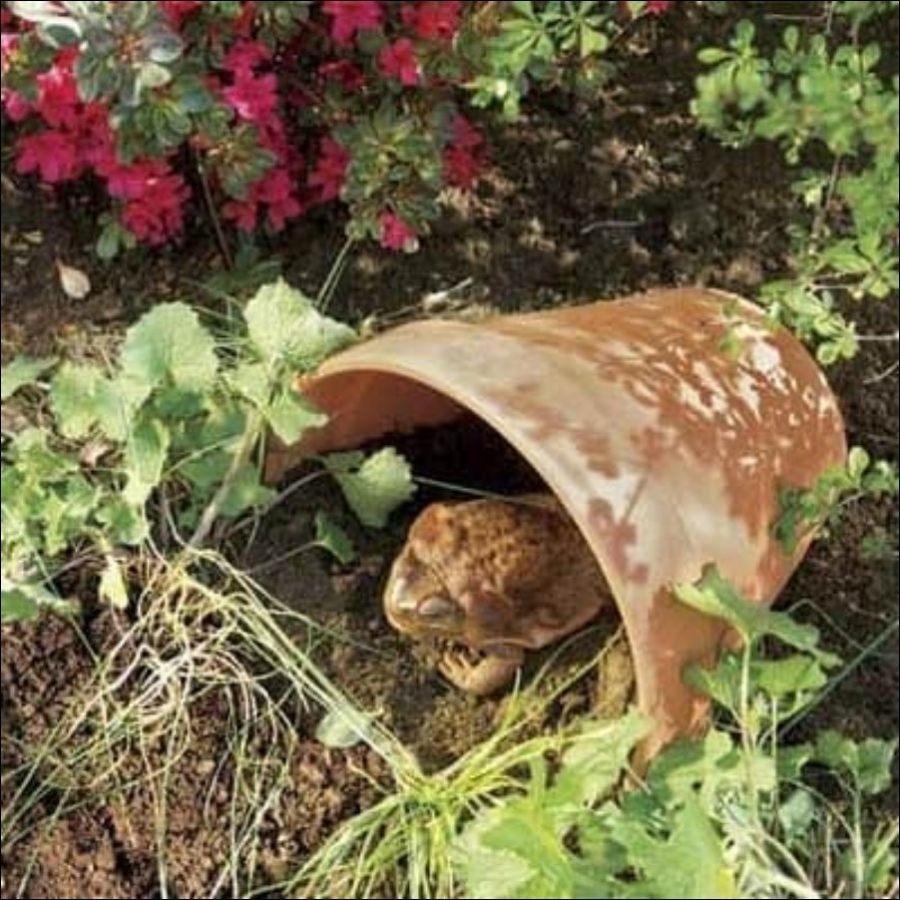
3. Protect the frogs from predators.
If you have a dog or cat, they might be quite interested in your newfound amphibian friends. When setting up your garden to attract frogs, be aware you need to take some precautions about their predators as well.
Since the frogs can seem like a good new toy and a treat for our furry friends, we should keep them a secret. Dedicate a place in the garden for them, and if you have the opportunity, make it non-accessible for your dog or cat. A chicken fence is an easy way to protect them from your family member.
However, if you have birds in your garden, and don’t wish them to eat your frogs, make sure you give them enough bird seeds to keep them full. Some bird species don’t eat seeds, and in those cases, you might want to buy some larvae for both the birds and your frogs to eat.
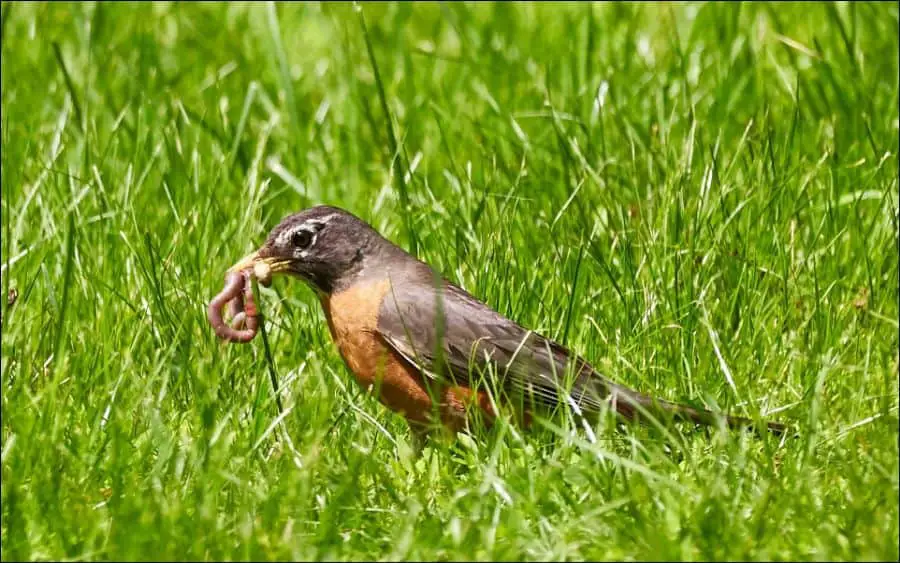
Rocks rock according to frogs.
Another way to make safe places for frogs is to build rock houses. I can find some flat surfaced rocks not far from here, which is great for building rock houses. Sticking the walls in the dirt and placing a flat rock as a roof is an easy way to build rock houses. Next time I will grab enough rocks to build an entire Bedrock city so both Barney and Fred can move in.

Piles of leaves is great for your garden for so many reasons.
Amphibians, hedgehogs, worms, shrews, chipmunks, slugs, and insects love to be in layers of leaves. Not only do the leaves provide warmth and moist, but also food. The worms eat the microbes on the leaves. The frogs eat the worms and insects, while hedgehogs eat the slugs.
By adding a leaf pile into your garden, you add an awesome mixture of wildlife and biodiversity into your garden. And protect some of them from outside predators.
4. Provide a hibernaculum for the frogs in your garden.
Frogs love to hide in damp, dark places. By digging a hibernaculum for them you will give them and other amphibians a perfect place to hibernate and sleep.
To start a hibernaculum, you need to dig a hole in the ground where it’s usually sunny. It should be 1’8 feet (50cm) deep and at least 5 feet wide (1.5m) wide.
Add multiple tubes sticking up to the surface so animals can easily walk up and down without any problem. Fill the hole with rocks, logs, and leaves. Make sure it has a lot of gaps in between so they can move inside. Different vegetation inside is good.
On the top, add a layer of dirt, and plant some grass and flowers, so it isn’t so noticeable. However, the tubes should be easy to notice. For bonus points, add sticks inside the tubes so they have something to grab on to so they don’t slide down if it is wet.
What month do frogs come out?
The breeding season for frogs is during spring, and you can expect frogs to return to the ponds. They perform a great show for their intended partner by sounding really loud and blowing up their vocal sack three times larger than their head. That really impresses the much larger female frog. I’m sure you have heard these concerts before.
Frogs usually come out from hibernation when the weather is warm enough. They prefer a minimum of 41° F (5° C) during the night. It is linked to local conditions and not a general rule when they decide to emerge.
Tadpoles in the pond usually leave during warm summer months. However, this can change due to the local climate. If the weather isn’t warm enough, they usually stay extra long in the pond. Sometimes they even wait until next spring.
If your tadpoles haven’t grown to frogs yet, that may be due to a lack of algae for them to eat, or it is too cold for them, which hinders their growth.
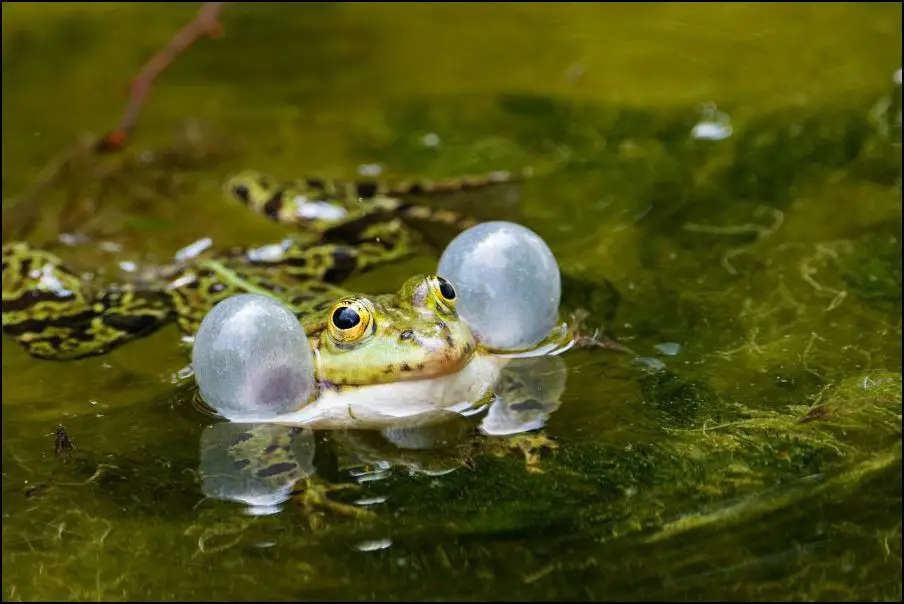
Benefits of having frogs in your garden
Having frogs in your garden can provide a number of benefits for both your plants and for the ecosystem as a whole. Frogs can help control pest populations by eating insects that can damage your plants, and they can also contribute to soil health by adding nutrients and increasing microbial activity. In addition, frogs can help pollinate flowers and disperse plant seeds, helping to promote the growth and reproduction of your plants. If you’re interested in learning more about the specific ways in which frogs help plants, you might want to check out our article “How Frogs Help Plants.” By creating a frog-friendly garden, you can not only support the health and survival of your plants, but also contribute to the overall health and well-being of the ecosystem.
How do you attract frogs to lay eggs?
Many of us have good memories as young collecting tadpoles or seeing frogspawn in the near pond.
Frogspawn is a bonus which comes with taking care of existing frogs and inviting new ones to your garden.
Frogs lay eggs where they see themselves at home. By providing a pond with both logs, rocks and plants, shelters like rocks and leaves piles but also a hunting ground for them gives them a motivation to stay with you.
If you have set up your pond and made your garden wildlife-friendly, the most important key is making it accessible. By digging small shallow depressions for the frogs on all sides of the fence to enter through you invite them and other small animals like hedgehogs for example, which will help you with your garden.
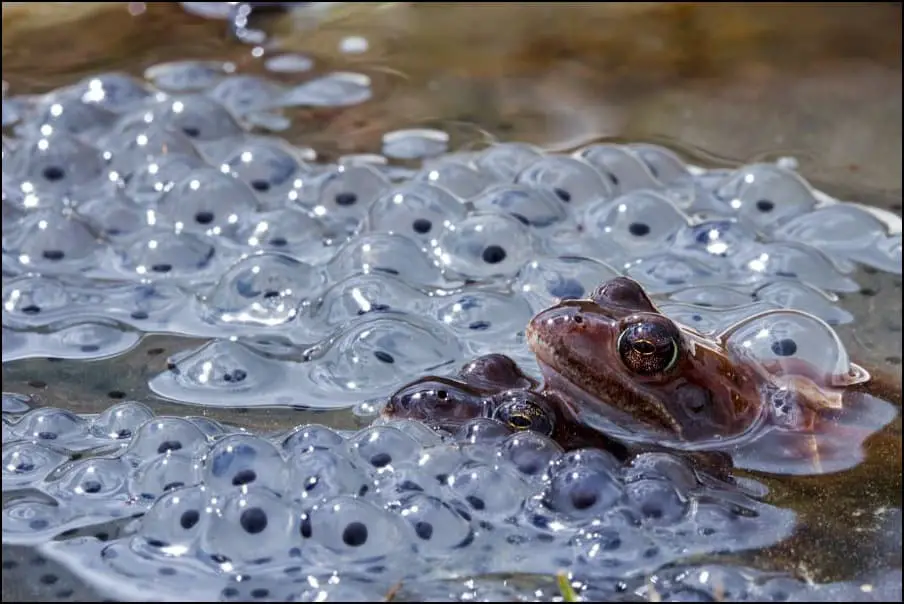
What attracts frogs to your garden?
Frogs are a bit like people. They enjoy a peaceful and quiet environment, good food, taking a bath, and hanging out with friends now and then.
Frogs enjoy a well-planned garden with several opportunities to both eat and sleep. The food supply should be in a variety between different animals. Insects and slugs are a favorite. Frogs are carnivorous on only eat meat. However, in their early stage as tadpoles, they are vegans and only eat algae.
The hunting ground should be well-planned which means there should be easily acccessed for them. When they emerge from hibernation they should easily get access to tall grass to hunt insects in or access to the pond.
A simple way to do this is to make sure you have a dedicated area in your garden for the frogs to move with ease between different stations.
The dedicated frog area of the garden should have these things:
- A pond.
- A hibernaculum.
- A leaf pile.
- Some pots to hide under.
- Some rock piles to hide under.
- An entrance and exit to and out of the garden.
- Restrictions for cats, dogs, and robotic lawnmowers.

Can I buy frogs for my pond?
It would be best if you did not buy or collect frogs from other places to be in your pond. Frogs can travel for 1.8 miles (3km) to get back to their birth pond. The best way for acquiring frogs is to be patient and let them come from their own will. Would you stay if you were kidnapped from your family by a stranger?
Please, do not collect baby frogs who are emerging from the water for the first time. If you wish to help them get a safe start in life, you can help them go across the road. If frogs are heading to a road, put them in a bucket with a little bit of water and help them get across. Please don’t touch them with your hands since it can damage their sensitive skin.
Don’t buy exotic frogs or toads from pet shops and place them in your pond. These animals should instead be in their natural habitat. In an exotic place. Neither in a tank or your pond.
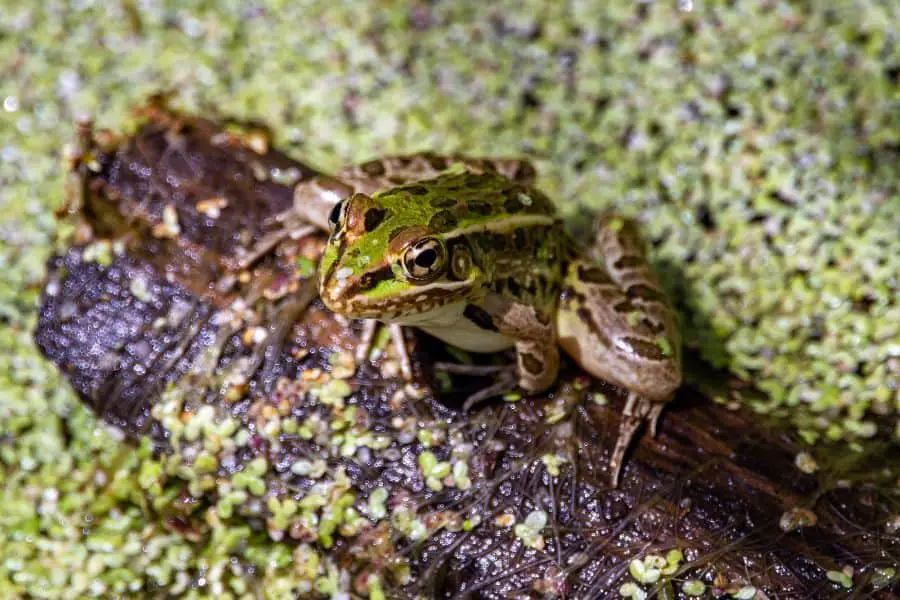
How to encourage frogs to your pond.
After you have built your pond and you are satisfied with it, make sure the frogs have several places to enter your garden. There should be at least one on every side.
The greatest attraction you can have is patience. The frogs will come, but it might take some time until they do. Until then, you could build more stuff for them. For example, a hibernaculum. The frogs will be looking for a safe place to hibernate, and if your hibernaculum is the best around, rumors will spread. When they emerge from hibernation, they will be able to root themselves in your garden and enjoy your pond.
Best plants for frogs.
The best plants for frogs are native plants. Water lilies are a classic plant for ponds and frogs. The lily provides good shading and a good resting place for the frog to sit. I prefer the pink Chalily water lily since it not so eager to take over the pond. The pink colors of it make it pleasant to look at.
Surrounding the pond you should use a shrub which protects it and makes it easy for the frogs to hide in. I usually go for ferns.
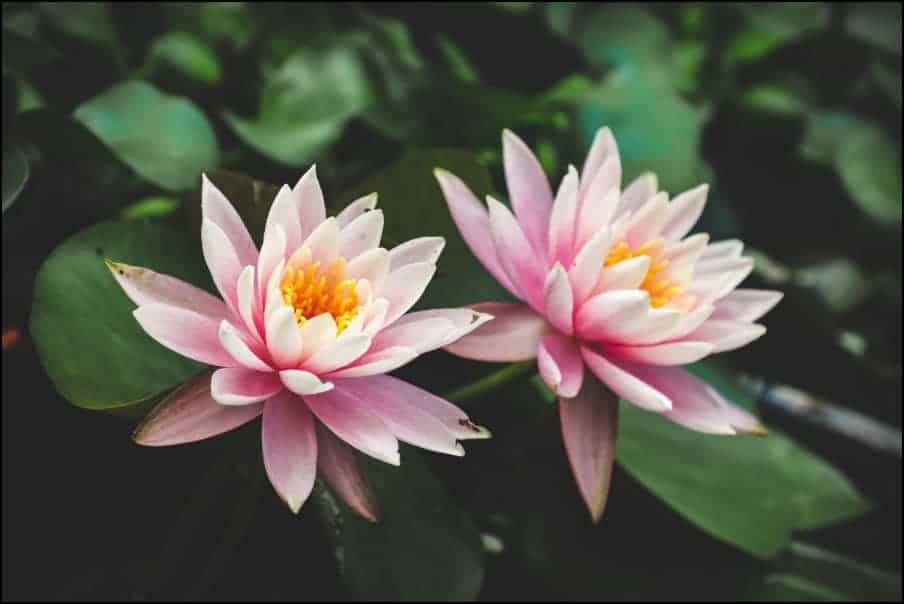
What is the reason the frogs aren’t coming to the yard?
If you have done everything by the book. You have made the best pond in the neighborhood. You have made an excellent hibernaculum and several hiding spots for them. But the frogs don’t show up anyway. You might have some other problem.
- Your garden isn’t wet enough. Frogs love everything wet. Is the grass perhaps too dry?
- You are using pesticides. Have you perhaps used any chemicals to kill other animals? Try to get rid of it.
- Frogs hate vinegar. Have you used it to repel some other animals or to do some spring cleaning?
- There isn’t any food in your garden. Suppose there aren’t any bugs or insects for them to eat. They ain’t coming.
- Are there predators in the garden? Perhaps is a cat or dog frightening the frogs away?
- Are you keeping it too clean? Frogs enjoy when there isn’t perfection. Let there be a little grassy.
- There’s a draft in the places. Make sure the resting place entrance aren’t facing north or northeast.
